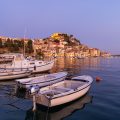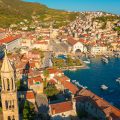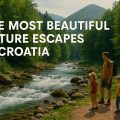From ancient wonders to modern marvels, here are the top 10 must-see destinations on Pag Island that promise unforgettable experiences and memories.
Nestled in the azure waters of the Adriatic Sea, Pag Island stands as a testament to Croatia’s diverse and captivating landscapes. This crescent-shaped haven, often overlooked by mainstream tourism, offers a unique blend of natural wonders, rich history, and vibrant culture. As travellers seek authentic experiences off the beaten path, Pag Island emerges as a hidden gem waiting to be explored.
Table of Contents
With its rugged coastline, pristine beaches, and otherworldly terrains, Pag Island presents a stark contrast to the lush greenery typically associated with Mediterranean isles. The island’s distinctive character is shaped by the powerful Bora wind, which has sculpted its landscapes over millennia, creating an environment that is both harsh and breathtakingly beautiful.
From ancient olive groves to pulsating beach parties, Pag Island caters to a wide array of interests. History enthusiasts can delve into medieval towns, while nature lovers can marvel at unique geological formations. Gourmands will delight in the island’s renowned culinary offerings, including the celebrated Pag cheese. As we embark on this journey through Pag’s top 10 wonders, prepare to be captivated by an island that defies expectations and promises unforgettable experiences.
1. The Martian Landscape at Metajna: Pag’s Otherworldly Terrain
Stepping onto the barren expanse of Metajna feels like a journey to another planet. This lunar-like landscape, sculpted by the relentless Bora wind from Velebit Mountain, stretches as far as the eye can see, creating an ethereal atmosphere that captivates visitors. The stark beauty of this region is a testament to the raw power of nature and its ability to craft extraordinary scenery.
Metajna’s otherworldly terrain is characterised by its rocky outcrops, sparse vegetation, and a palette of muted greys and browns. This unique environment provides a stark contrast to the turquoise waters of the Adriatic that lap at its shores. Photographers and nature enthusiasts flock to this area, eager to capture the surreal vistas and experience the eerie silence that permeates the landscape.
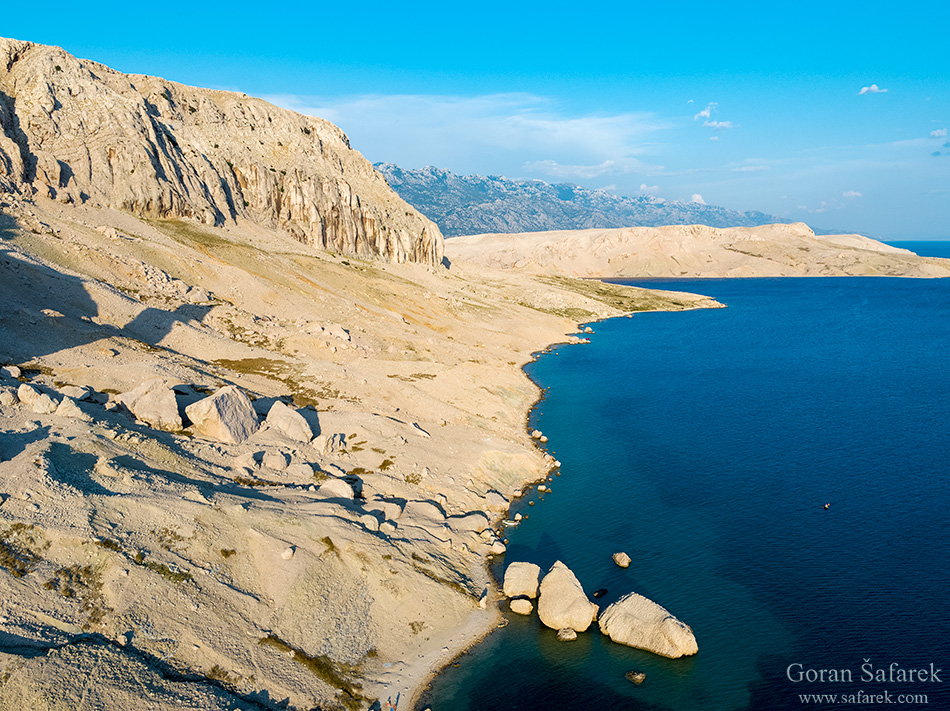
For those seeking adventure, hiking through Metajna’s alien terrain offers an unparalleled experience. As visitors traverse the rocky paths, they may encounter hardy plant species that have adapted to the harsh conditions, adding splashes of colour to the monochromatic landscape. The area also serves as a habitat for various bird species, making it a prime spot for birdwatching enthusiasts.
💡 Day Trip Idea from Zadar:
Pag’s Martian Landscape – Hiking & City Stroll
Experience the wild beauty of Pag Island on a full-day tour from Zadar. Drive across the iconic Pag Bridge and explore the barren “Mars-like” terrain near Metajna on an easy-to-moderate hike with hidden coves and panoramic sea views.
After time to relax and swim, enjoy a leisurely walk through the old town of Pag — filled with charming cafés, lace shops, and local culture.
🕗 Departure: 8:00 a.m. – Return around 18:00
🚐 Small groups, guided experience, transfers included.
👉 Read more or book this Pag Island Hiking & City Tour
2. Zrće Beach: The Party Capital of the Adriatic
Zrće Beach stands in stark contrast to the tranquil landscapes found elsewhere on Pag Island. Known as the ‘Ibiza of Croatia’, this pebble beach transforms into a pulsating hub of electronic music and round-the-clock parties during the summer months. International DJs and revellers from across the globe converge on this stretch of coastline, creating an electric atmosphere that reverberates through day and night.
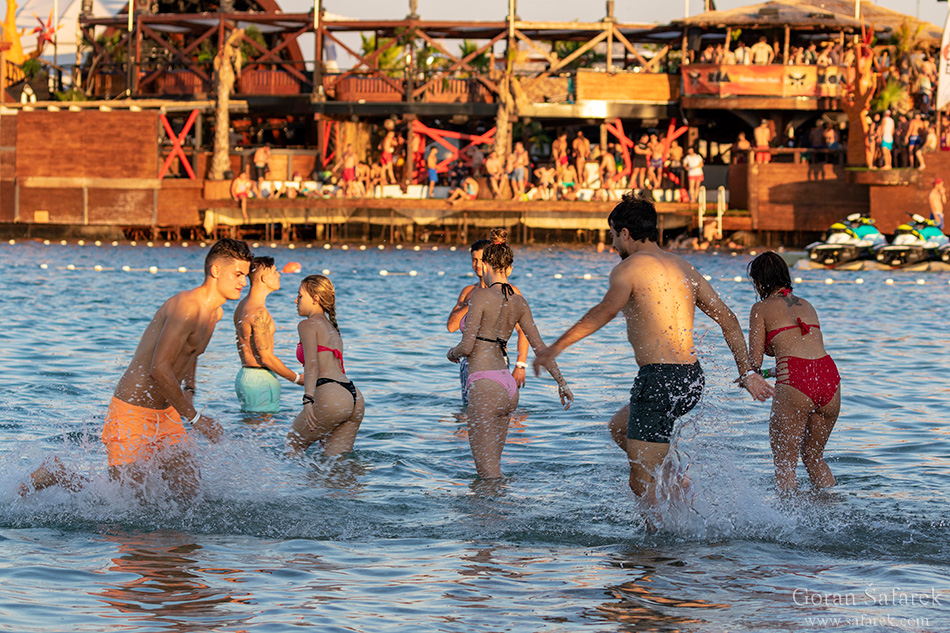
The beach boasts several world-renowned open-air clubs, each offering a unique ambience and music style. From sunrise yoga sessions to sunset boat parties and all-night raves, Zrće caters to party-goers of all stripes. The crystal-clear waters of the Adriatic provide a refreshing respite for those looking to cool off between dance sessions.
🎉 Don’t Miss: Zrće Booze Cruise
Spend an unforgettable day (or sunset!) partying at sea with resident DJs from Zrće’s top clubs, a high-end sound system, and ice-cold drinks served on board.
This 3-hour all-inclusive boat party departs twice daily from Novalja’s main port — featuring swim stops, drinking games, and nonstop fun with travelers from around the world.
🚤 Departures: Twice daily from Novalja port
🍹 Drinks, music & good vibes included
👉 Book your Zrće Boat Party here
While Zrće Beach is synonymous with its vibrant nightlife, it also offers a range of daytime activities for those seeking a more relaxed experience. Visitors can indulge in water sports, lounge on the beach, or enjoy a meal at one of the many seaside restaurants. The juxtaposition of Zrće’s energetic atmosphere against the backdrop of Pag’s rugged landscape creates a truly unique and unforgettable experience.
💥 Adrenaline Highlight: Zrće Bungee Jump
Take the plunge on an exhilarating 15-minute adventure at the famous Zrće bungee site — the ultimate thrill of Pag Island since 2004. Leap into the abyss from 55 meters (180 ft) above the Adriatic, surrounded by epic sea views and music from the beach below.
Jumps are available by day or night, and every brave soul receives a certificate to remember the experience. Safety is the top priority — all professional equipment is included.
📍 Location: Zrće Beach, Novalja
⏱️ Duration: ~15 minutes
👉 Book your Zrće Bungee Jump here
3. From the Road on the Moon to the Life on Mars Trail – Exploring Pag’s Lunar World
The Prizna – Novalja Road, aptly nicknamed ‘Road on Moon’, offers travellers a journey through some of Pag Island’s most dramatic and otherworldly landscapes. This winding route snakes its way across the island’s northern region, providing panoramic views of barren hills, rocky outcrops, and the shimmering Adriatic Sea.
As visitors traverse this lunar-like terrain, they are treated to a visual spectacle that seems more akin to a science fiction film set than a Mediterranean island. The road’s twists and turns reveal new vistas at every bend, with the interplay of light and shadow creating an ever-changing tableau. The stark beauty of the landscape is accentuated by the occasional glimpse of traditional stone walls, remnants of the island’s agricultural past.
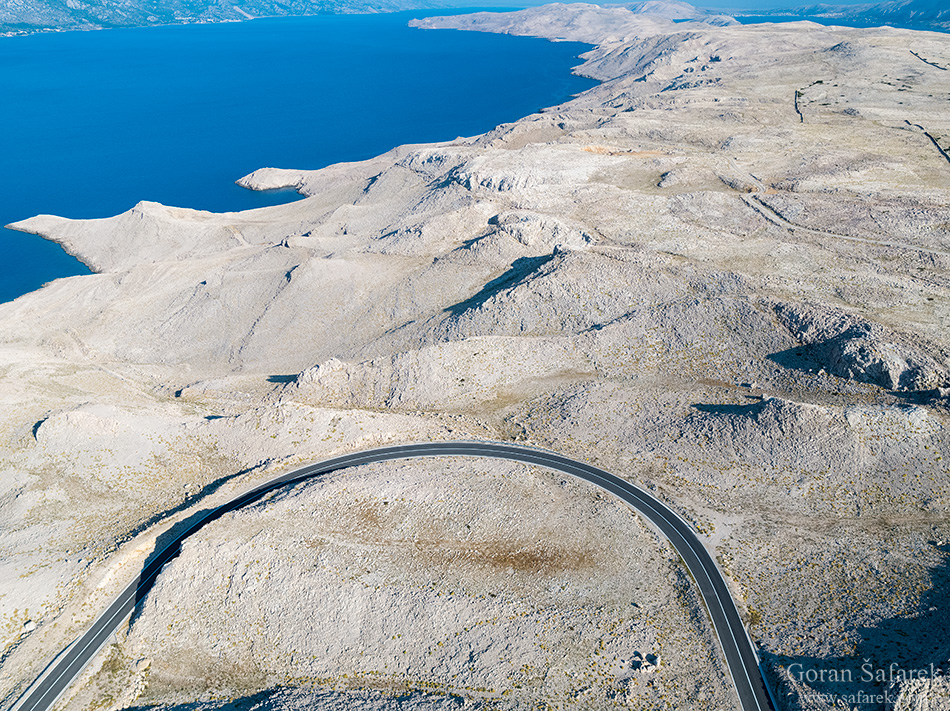
Not far from this scenic road lies one of Pag’s most fascinating hiking routes — the Life on Mars Trail near Metajna. Carved through the same desolate, rocky terrain, this trail invites travellers to walk through landscapes that feel untouched by time. The path meanders along coastal cliffs, hidden coves, and surreal stone formations, offering both a physical challenge and a deep sense of connection to Pag’s raw, elemental nature. Whether explored under the blazing midday sun or beneath a sky full of stars, the Life on Mars Trail perfectly complements the lunar beauty of the island’s northern landscapes.
🌙 Special Experience: Night Hiking “Life on Mars”
Discover the magic of Pag’s wild coast under the starry sky. This guided night hike follows the famous “Life on Mars” trail — across the karstic landscape of Pag Bay toward Beriknica Beach, known for its dramatic rock formations sculpted by the bura wind.
Continue to Slana Bay and a hidden freshwater spring, then enjoy a night swim at Seline Bay while admiring the silhouette of the Velebit mountains in the moonlight.
🌌 Peaceful night ambience & stargazing
🥾 Easy guided hike with swim stops
👉 Book your Night Hiking “Life on Mars” Tour
For photography enthusiasts, both Life on Mars and the Prizna – Novalja Road offer countless opportunities to capture stunning images. The best times to experience this route are during the golden hours of sunrise and sunset when the low-angled light bathes the landscape in warm hues, emphasising its otherworldly character.
Travellers are advised to drive cautiously and take advantage of the numerous pull-offs along the way to safely admire the views and snap photographs.
4. The Salt Pans of Pag: A Centuries-Old Tradition
The salt pans of Pag Island stand as a testament to the enduring relationship between the islanders and their environment. These expansive, shallow pools have been used for salt production since Roman times, playing a crucial role in the island’s economy and cultural identity. Today, they offer visitors a glimpse into a centuries-old tradition that continues to thrive in the modern era.
The process of salt harvesting on Pag is a delicate dance with nature. Seawater is channelled into the pans, where it slowly evaporates under the hot Mediterranean sun. As the water recedes, it leaves behind a crust of pure, white salt. This method, largely unchanged for generations, produces salt renowned for its exceptional quality and flavour.
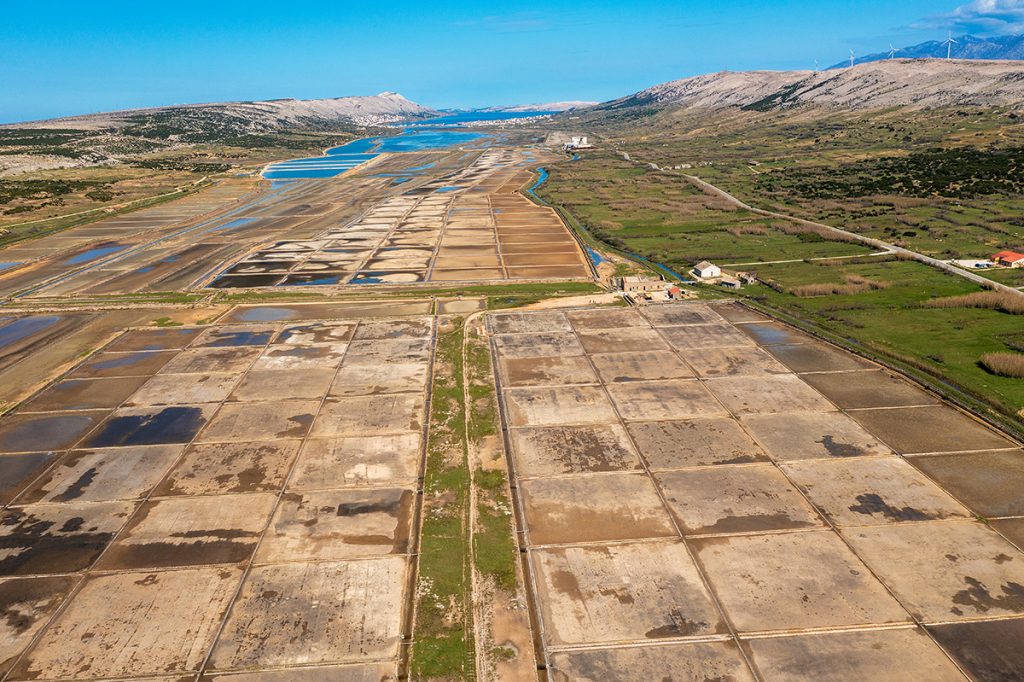
Visitors to the salt pans can observe the harvesting process firsthand, particularly during the summer months when production is at its peak. Guided tours offer insights into the history and techniques of salt-making, while the on-site museum showcases artefacts and exhibits that highlight the cultural significance of this industry. The salt pans also serve as an important ecological site, attracting a diverse array of bird species, making it a prime location for birdwatching.
👉 Find the best accommodation deals near the iconic Pag salt pans on this interactive map:
5. Šimuni Beaches: Green Oasis of Pag
In stark contrast to the barren landscapes that dominate much of Pag Island, the Šimuni beaches offer a lush, green retreat for visitors seeking a more traditional Mediterranean experience. This verdant oasis, nestled along the island’s western coast, boasts a string of pristine beaches fringed by pine forests and crystal-clear waters.
The Šimuni area is home to several beaches, each with its own unique character. From secluded coves perfect for couples seeking privacy to family-friendly stretches with shallow waters ideal for children, there’s a spot to suit every preference. The pebble and sand beaches are well-maintained and offer a range of amenities, including beach bars, water sports facilities, and shaded areas for those looking to escape the midday sun.
🏖️ Where to Stay: Best Accommodation at Šimuni Beach
Stay just steps away from one of Pag’s most beautiful beaches — Šimuni. Enjoy crystal-clear waters, pine shade, and the relaxed island vibe that makes this spot a favourite among families and nature lovers.
From seaside apartments to cozy mobile homes and boutique stays, you’ll find plenty of options for every budget.
👉 Find the best stays near Šimuni Beach on Booking.com
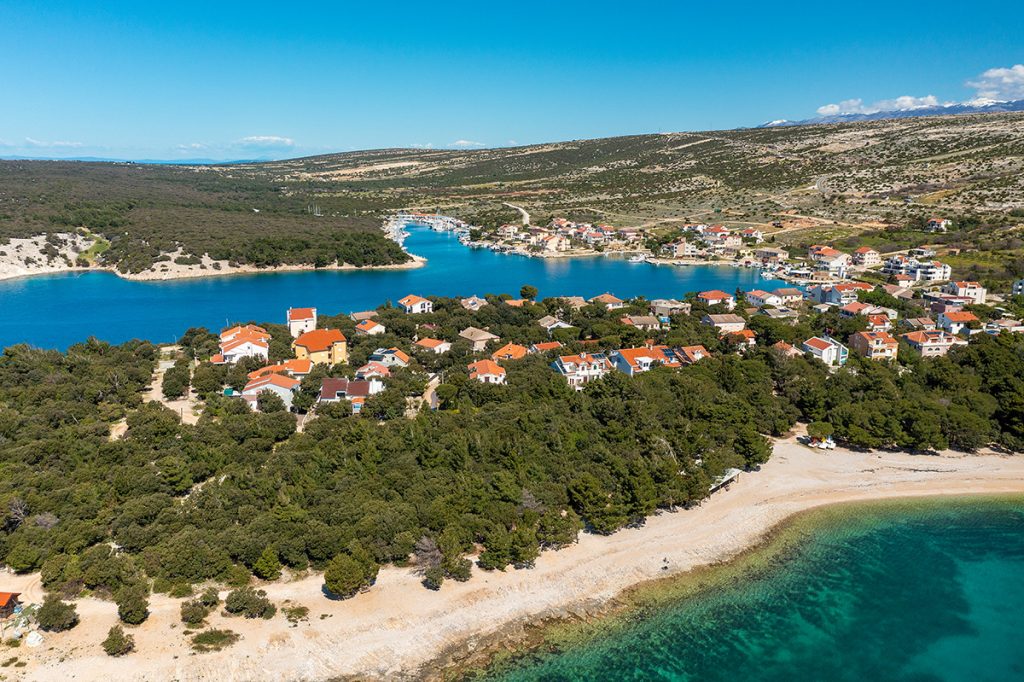
For a true seaside experience, stay at the popular Camping Šimuni — a vibrant beachfront resort offering bungalows, mobile homes, and pitches surrounded by pine trees and turquoise waters.
Nature enthusiasts will appreciate the rich biodiversity of the surrounding pine forests, which provide a habitat for various plant and animal species. The area is crisscrossed with hiking and cycling trails, offering opportunities to explore the lush interior and enjoy panoramic views of the coastline. As the day winds down, visitors can witness spectacular sunsets from the beaches, painting the sky in a riot of colours and providing a perfect end to a day in this green paradise.
6. The Olive Groves on Lun: Ancient Trees and Liquid Gold
At the northernmost tip of Pag Island lies Lun, home to one of the most remarkable olive groves in the Mediterranean. This ancient woodland, spanning over 24 hectares, is home to more than 80,000 olive trees, some of which are estimated to be over 1,000 years old. These gnarled, twisted trees stand as living monuments to the island’s rich agricultural heritage and its enduring connection to the land.
Visitors to Lun can wander through the groves along well-marked paths, marvelling at the ancient trees and learning about the traditional methods of olive cultivation still practised in the area. The oldest trees, with their massive trunks and sprawling canopies, exude a sense of timelessness and resilience, having weathered centuries of storms and droughts.
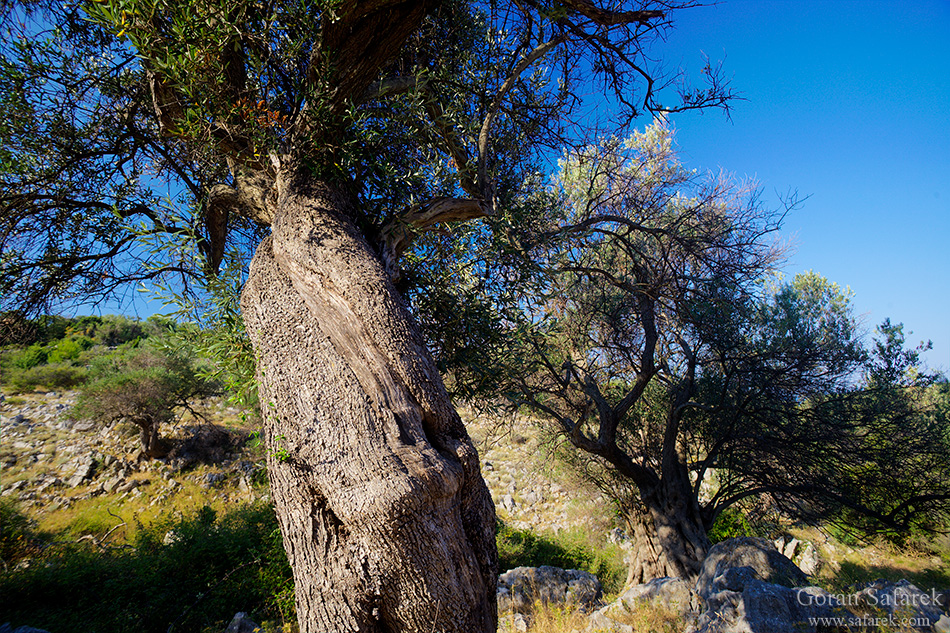
The olives harvested from these groves produce some of the finest olive oil in Croatia, often referred to as ‘liquid gold’. Visitors can participate in olive oil tastings, learning to discern the subtle flavours and aromas that make Pag’s olive oil so prized.
The local olive oil museum provides insights into the history and cultural significance of olive cultivation on the island, while small producers offer the opportunity to purchase authentic, high-quality olive oil as a delicious souvenir of the Pag experience.
🌿 Where to Stay: Best Hotels in Lun
Spend the night surrounded by ancient olive groves and the tranquil beauty of northern Pag. Lun offers a handful of charming boutique hotels and guesthouses — perfect for a peaceful island escape.
👉 Find the best hotels in Lun here
7. Pag Town: A Stroll Through Medieval History
Pag Town, the island’s largest settlement, offers visitors a captivating journey through centuries of history. Founded in the 15th century, this picturesque town boasts a well-preserved medieval core that transports visitors back in time. The town’s layout, with its geometric street pattern and fortified walls, reflects the Renaissance urban planning ideals of the Venetian Republic, which ruled the island for centuries.
At the heart of Pag Town lies the main square, dominated by the striking facade of the Church of the Assumption of Mary. This 15th-century church, with its blend of Gothic and Renaissance styles, stands as a testament to the town’s rich cultural heritage. Nearby, the Duke’s Palace and the old town hall offer further glimpses into Pag’s illustrious past.
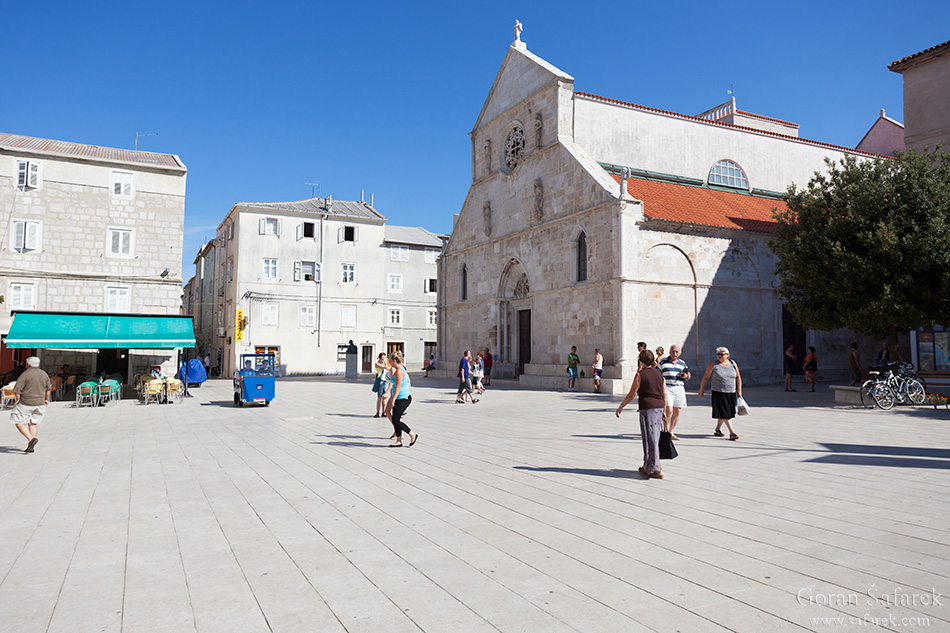
🏨 Best Places to Stay in Pag Town – Interactive Map
Explore top hotels, apartments, and boutique stays around Pag Town. Zoom in/out to compare locations, prices, and availability.
As visitors wander through the narrow, cobblestone streets, they’ll encounter numerous examples of traditional stone architecture, including the distinctive Pag windows with their intricate stone carvings. The town is also renowned for its lacemaking tradition, recognised by UNESCO as Intangible Cultural Heritage. Visitors can observe skilled artisans creating delicate lace pieces and learn about this centuries-old craft at the Lace Museum.
8. Novalja: Blending Modern Amenities with Island Charm
Novalja, the second-largest town on Pag Island, strikes a perfect balance between traditional island life and modern tourist amenities. This vibrant coastal town serves as a gateway to many of Pag’s attractions, including the famous Zrće Beach, while maintaining its own unique charm and character.
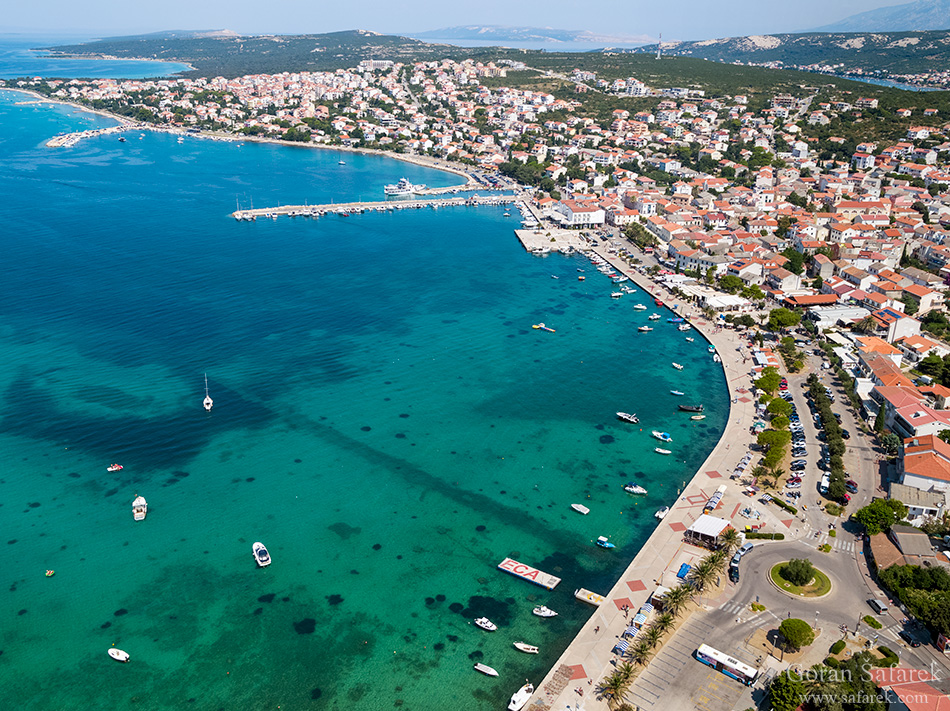
The town centre of Novalja is a delightful mix of old and new. Historic stone buildings housing quaint shops and traditional konobas (taverns) sit alongside modern cafes, restaurants, and boutiques. The waterfront promenade, lined with palm trees and bobbing fishing boats, provides a picturesque setting for evening strolls and al fresco dining.
Novalja boasts several beautiful beaches within easy reach of the town centre. Planjka Beach, also known as Trinćel, is particularly popular with families due to its shallow waters and fine pebble shore.
Pag’s charm extends far beyond its beaches — it also hides a whole world beneath the surface.
In the crystal-clear waters around Novalja, you can dive among rocky reefs and quiet blue depths, discovering the island from a completely new perspective.
Whether you’re a beginner or a certified diver, this is one of the most peaceful and awe-inspiring adventures you can have on Pag.
🤿 Diving in Novalja – Explore the Underwater World of Pag
Dive into the Adriatic Sea with a friendly local diving center in Novalja. Choose from discovery dives, full courses, or guided underwater excursions — and capture epic photos beneath the waves.
👉 Check prices and book your Novalja diving experience
For those interested in history, the Roman aqueduct, parts of which can still be seen today, offers a fascinating glimpse into the island’s ancient past.
If you are planning to stay a little longer, Pag Town offers a great selection of seaside apartments, boutique hotels, and family-run guesthouses just steps from the old town and the beach — a perfect base for exploring the rest of the island.
9. Birdwatching on Freshwater and Brackish Wetlands
Pag Island’s diverse ecosystems include several freshwater and brackish wetlands that serve as crucial habitats for a wide variety of bird species. These areas, often overlooked by casual visitors, offer nature enthusiasts and birdwatchers a chance to observe some of Croatia’s most interesting avian residents and migratory species.
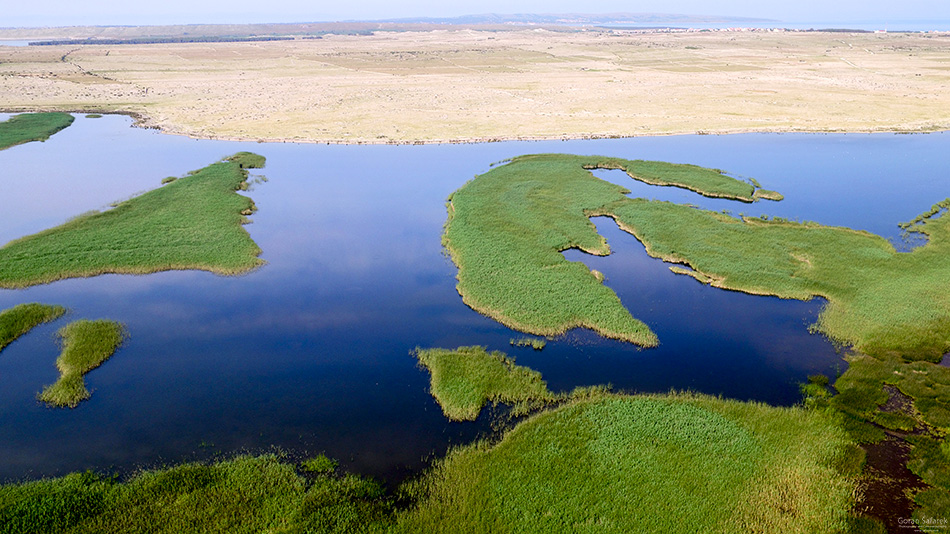
The Veliko Blato ornithological reserve, located near Povljana in the southern part of the island, is a prime spot for birdwatching. This shallow, brackish lake attracts numerous species of waders, ducks, and other water birds. During migration seasons, the reserve becomes a stopover for many species travelling between their breeding and wintering grounds, offering birdwatchers the chance to spot rare and unusual visitors.
Another notable area for birdwatching is the salt pans near Pag Town. The unique ecosystem created by the salt production process attracts a variety of bird species, including flamingos, spoonbills, and various species of gulls and terns. Guided birdwatching tours are available, providing expert insights into the island’s avian population and the best techniques for observing and identifying different species.
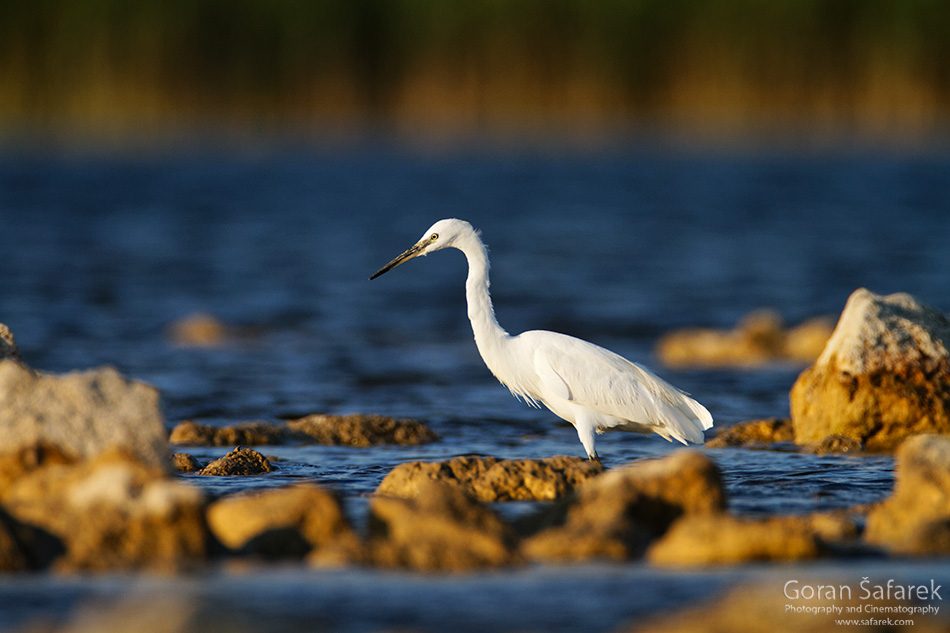
10. Pag Bridge and Fortica Fortress
The Pag Bridge, connecting the island to the mainland, serves as both a vital transportation link and a remarkable feat of engineering. Spanning 301 metres across the Pag strait, this elegant structure offers breathtaking views of the surrounding landscape and the turquoise waters below. For many visitors, crossing the bridge marks the beginning of their Pag Island adventure, providing a dramatic introduction to the island’s rugged beauty.
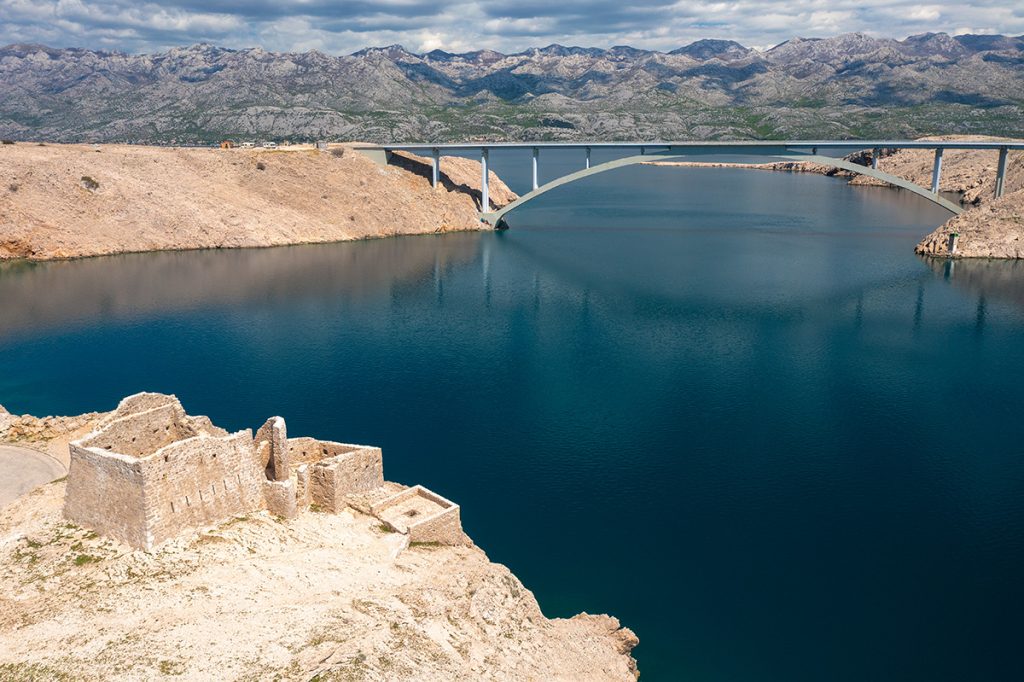
Perched on a hill overlooking Pag Bridge, the ruins of Fortica Fortress stand as a silent sentinel, guarding the island’s history. Built in the 15th century as part of the Pag’s defences, the fortress offers visitors panoramic views of the countryside and Velebit Mountain. The climb to the fortress is rewarded with stunning vistas and a tangible connection to the island’s strategic importance throughout history.
Together, the Pag Bridge and Fortica Fortress bookend the visitor’s experience of Pag Island. The bridge represents the modern connection to the wider world, while the fortress serves as a reminder of the island’s rich past. Both structures provide unique perspectives on Pag’s landscape, inviting visitors to appreciate the island’s natural beauty and historical significance from different vantage points.
Planning Your Visit: Best Times and Ways to Explore Pag Island
To fully appreciate the wonders of Pag Island, careful planning is essential. The best time to visit depends largely on personal preferences and interests.
Summer (June to August) is the peak tourist season, offering warm weather and a vibrant atmosphere, particularly around Zrće Beach. However, this period also brings larger crowds and higher prices.
Read our The Ultimate Pag Island Travel Guide
Spring (April to May) and autumn (September to October) offer milder temperatures and fewer tourists, making these seasons ideal for those interested in outdoor activities, cultural experiences, and a more relaxed pace.
Winter visitors can experience the island’s rugged beauty in solitude, though some tourist facilities may be closed during this period.
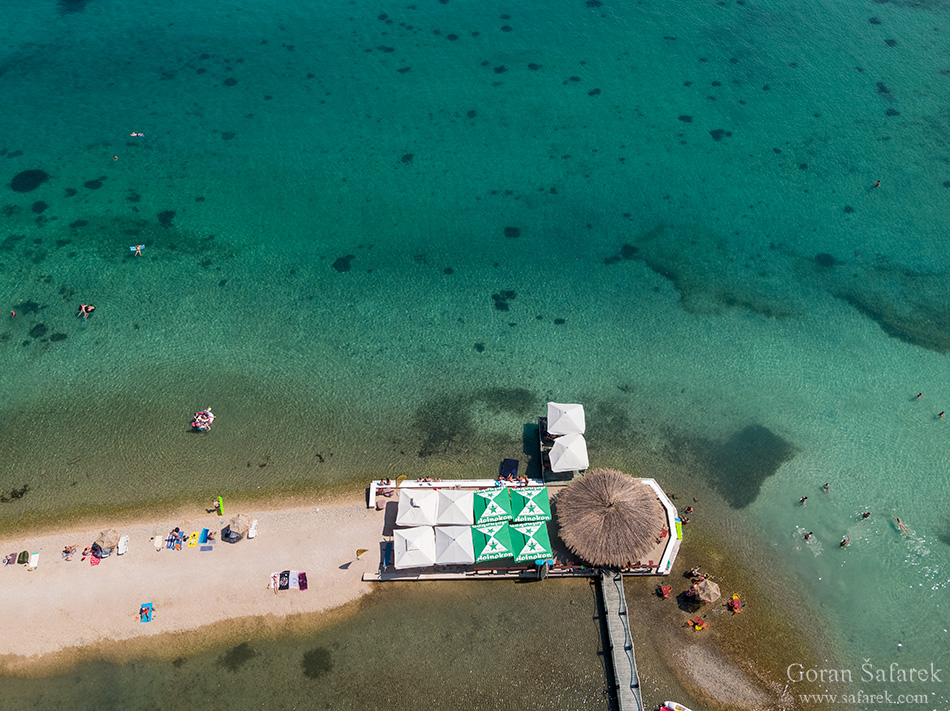
To explore Pag’s diverse attractions, renting a car is highly recommended. This allows for flexibility in visiting remote beaches, scenic viewpoints, and historical sites at your own pace.
For those preferring guided experiences, numerous tour operators offer excursions covering the island’s highlights.
🚗 Rent a Car on Pag Island
The best way to explore Pag’s hidden beaches, lunar landscapes, and small villages is by car. Enjoy the freedom to move at your own pace — from the olive groves of Lun to the salt pans of Pag Town.
👉 Compare car rental deals on Pag and book online
Accommodation options on Pag Island range from stylish seaside resorts and boutique hotels to cozy family apartments and scenic campsites surrounded by pine trees.
Whether you’re staying in lively Novalja, historic Pag Town, or peaceful coastal villages like Šimuni and Lun, you’ll find something for every style and budget.
Booking in advance is highly recommended, especially in July and August when the island is at its busiest.
👉 Find the best accommodation deals across Pag Island on the interactive map below:
Ready to embark on your Pag Island adventure?
Start planning your journey today and discover the unique wonders of this Croatian gem. From otherworldly landscapes to pristine beaches, ancient traditions to modern festivities, Pag Island offers a travel experience like no other. Don’t miss the opportunity to create unforgettable memories in this hidden paradise of the Adriatic.
As you explore Pag’s top 10 wonders, remember to respect the island’s natural environment and cultural heritage. By treading lightly and engaging respectfully with local communities, you’ll contribute to the preservation of this extraordinary destination for future generations of travellers to enjoy.
💬 FAQ – Pag Island Travel Guide
Pag Island is easily accessible by car via the Pag Bridge from the mainland or by ferry from Prizna to Žigljen. Regular bus connections also operate from Zadar, Split, and Zagreb.
If you’re flying into Zadar, you can rent a car online here for easy travel around the island.
The best time to visit Pag is from May to September, when the weather is warm and the sea is perfect for swimming. For fewer crowds and lower prices, choose May–June or September.
For nightlife and beaches, Novalja and Zrće are top picks.
For culture and food, choose Pag Town.
For peace and nature, head to Šimuni or Lun among olive groves and quiet coves.
You can compare hotels and apartments here across all Pag Island destinations.
Don’t miss Pag cheese, lamb, and salt, all unique to the island’s landscape. Pair them with local olive oil and a glass of Dalmatian wine for the true island flavour.
While buses and taxis connect major towns, renting a car gives you full freedom to explore hidden beaches, remote viewpoints, and charming inland villages at your own pace.
👉 Check car rental options on Pag Island.


